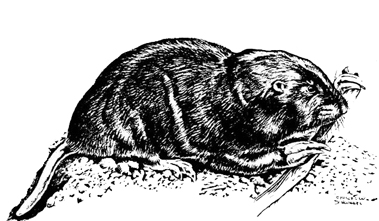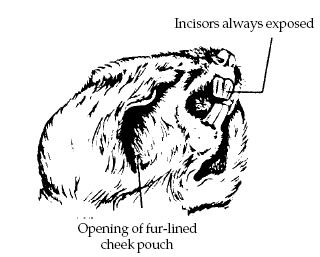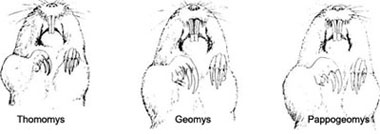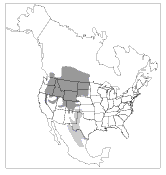|
Pocket Gophers | Pocket Gopher Overview | Pocket Gopher Damage Assessment | Pocket Gopher Damage Management | Pocket Gopher Resources | Pocket Gopher Acknowledgments | ICWDM | Wildlife Species Information |

Figure 1. Plains pocket gopher, Geomys bursarius.
Contents |
Identification
Pocket gophers (Fig. 1) are fossorial (burrowing) rodents, so named because they have fur-lined pouches outside of the mouth, one on each side of the face (Fig. 2).

These pockets, which are capable of being turned inside out, are used for carrying food. Pocket gophers are powerfully built in the forequarters and have a short neck; the head is fairly small and flattened. The forepaws are large-clawed and the lips close behind their large incisors, all marvelous adaptations to their underground existence.
Gophers have small external ears and small eyes. As sight and sound are severely limited, gophers are highly dependent on the sense of touch. The vibrissae (whiskers) on their face are very sensitive to touch and assist pocket gophers while traveling about in their dark tunnels. The tail is sparsely haired and also serves as a sensory mechanism guiding gophers’ backward movements. The tail is also important in thermoregulation, acting as a radiator.
Pocket gophers are medium-sized rodents ranging from about 5 to nearly 14 inches (13 to 36 cm) long (head and body). Adult males are larger than adult females. Their fur is very fine, soft, and highly variable in color. Colors range from nearly black to pale brown to almost white. The great variability in size and color of pocket gophers is attributed to their low dispersal rate and thus limited gene flow, resulting in adaptation to local conditions.
Thirty-four species of pocket gophers, represented by five genera, occupy the western hemisphere. In the United States there are 13 species and three genera. The major features differentiating these genera are the size of their forefeet, claws, and front surfaces of their chisel-like incisors (Fig. 3).

Figure 3. These three genera of pocket gophers can be differentiated by relative size of forefeet and front surfaces of upper incisors.
Thomomys have smooth-faced incisors and small forefeet with small claws. Northern pocket gophers (Thomomys talpoides) are typically from 6 1/2 to 10 inches (17 to 25 cm) long. Their fur is variable in color but is often yellowish brown with pale underparts. Botta’s (or valley) pocket gophers (Thomomys bottae) are extremely variable in size and color. Botta’s pocket gophers are 5 inches to about 13 1/2 inches (13 to 34 cm) long. Their color varies from almost white to black.
Geomys have two grooves on each upper incisor and large forefeet and claws. Plains pocket gophers (Geomys bursarius) vary in length from almost 7 1/2 to 14 inches (18 to 36 cm). Their fur is typically brown but may vary to black. Desert pocket gophers (Geomys arenarius) are always brown and vary from nearly 8 3/4 to 11 inches (22 to 28 cm) long. Texas pocket gophers (Geomys personatus) are also brown and are from slightly larger than 8 3/4 to nearly 13 inches (22 to 34 cm) long. Southeastern pocket gophers (Geomys pinetis) are of various shades of brown, depending on soil color, and are from 9 to 13 1/4 inches (23 to 34 cm) long.
Pappogeomys have a single groove on each upper incisor, and like Geomys, have large forefeet with large claws. Yellow-faced pocket gophers (Pappogeomys castanops) vary in length from slightly more than 5 1/2 to just less than 7 1/2 inches (14 to 19 cm). Their fur color varies from pale yellow to dark reddish brown. Their underparts vary from whitish to bright yellowish buff. Some hairs on the back and top of the head are dark-tipped.
General Biology, Reproduction, and Behavior
Just as cheek pouches are used in identification of pocket gophers, their fan-shaped soil mounds are characteristic evidence of their presence. Typically, there is only one gopher per burrow system. Obvious exceptions are when mating occurs and when the female is caring for her young.
All pocket gophers use their claws and teeth while digging. Geomys, however, are primarily claw diggers, while Thomomys do much more tooth digging, and Pappogeomys are intermediate between the two. Soil, rocks, and other items loosened by this means are kicked away from the digging area with the hind feet. Gophers then turn over, making a sort of somersault within the confines of their burrow, and use their forefeet and chest to push the materials out of the burrow.
The incisors of pocket gophers, as in all rodents, grow continuously to repair the wear and tear on the teeth. On the other hand, gophers must gnaw continuously to keep their teeth ground to an appropriate length. Gophers exert tremendous pressure with their bite, up to 18,000 pounds per square inch (1,265 kg/cm2).
Burrow systems consist of a main burrow, generally 4 to 18 inches (10 to 46 cm) below and parallel to the ground surface, with a variable number of lateral burrows off the main one. These end at the surface with a soil mound or sometimes only a soil plug. There are also deeper branches off the main burrow that are used as nests and food caches. Enlargements along the main tunnel are probably feeding and resting locations. Nest chambers have dried grasses and other grasslike plants formed into a sphere. The maximum depth of at least some portion of a burrow may be as great as 5 or 6 feet (1.5 or 1.8 m). The diameter of a burrow is about 3 inches (7.6 cm) but varies with the body size of the gopher.
Burrow systems may be linear or highly branched. The more linear systems may be those of reproductive males, since this shape would increase the likelihood of encountering a female’s burrow. The number of soil mounds on the surface of the ground may be as great as 300 per animal in a year. Burrows are sometimes quite dynamic, with portions constantly being sealed off and new areas excavated. A single burrow system may contain up to 200 yards (180 m) of tunnels. The poorer the habitat, the larger the burrow system required to provide sufficient forage for its occupant.
The rate of mound building is highly variable. Estimates include an average of 1 to 3 per day, and up to 70 mounds per month. This activity brings large amounts of soil to the surface, variously estimated at 2 1/4 tons (2 mt) per gopher each year, or 46 3/4 tons per acre (103.9 mt/ha) for a population of 50 southern pocket gophers.
The tunnel system tells us much about its inhabitant. The system is rigorously defended against intruders and constitutes the home range of the pocket gopher, which may be up to 700 square yards (560 m2).
Pocket gophers also tunnel through snow, above the ground. Soil from below ground is pushed into the snow tunnels, but mounds are not built. When the snow melts, the soil casts (tubes) remain on the ground until they weather away. Soil casts are left by both Thomomys and Geomys in areas where snow cover is adequate for burrowing.
Pocket gophers do not hibernate. Some observers believe their activities peak at dawn and dusk, but various studies have shown them to be active throughout the day, with activity periods interspersed with rest. Mound building by plains pocket gophers increases in spring, frequently declines during summer, and increases again in fall. In Thomomys, mound building increases from spring through summer into fall. Tunneling underground is a tremendously demanding activity estimated to require 360 to 3,400 times the energy of moving across the surface. Thus, this activity must be of great importance to the pocket gopher’s survival, either increasing its chance of breeding, or finding needed food resources.
Pocket gophers reach sexual maturity in the spring following their birth. In the northern part of their range they have 1 litter per year. In the southern portion they may have 2 litters per year. One researcher has suggested that Thomomys in irrigated alfalfa in California may breed throughout the year.
Litter sizes range from 1 to 10 but typically average 3 to 4. In some southern portions of their range where 2 litters are born each year, litter size is usually smaller, averaging about 2. The breeding season also varies, but births typically occur from March through June. The gestation period is 18 or 19 days for the northern pocket gopher, but periods as long as 51 days for the plains pocket gopher have been reported. Sex ratios are typically in favor of females, generally ranging from 55% to 60% females for Geomys.
In Thomomys, the sex ratio is often 50:50 but it varies seasonally. There may be more males than females in spring, and the reverse for summer and fall. Pocket gophers have been thought to be polygamous (one male mating with two or more females), but serial monogamy may be the case. The male cohabits a tunnel system and may help care for young before moving on to another female’s burrow system. Some researchers believe both sexes move mainly underground from their own to other burrows during the breeding season.
Densities reported for various pocket gophers are highly variable. Densities of 16 to 20 per acre (40 to 49/ha) are very common for Thomomys, but they may attain densities up to 62 per acre (153/ha). For Geomys, 6 to 8 per acre (20/ha) are representative of high densities. Average life span of gophers appears to change inversely with population density. Average longevity for Thomomys ranges from just over 1 year to nearly 3 years. Geomys may live to an average age of 2, and reach a maximum age in the wild in excess of 7 years.
Sharp declines in gopher populations have been noted on several occasions. Usually some climatic factor is associated with a marked decline. An example would be a heavy snow cover, then rapid snowmelt with a concomitant rise in the water table. External parasites are often found on pocket gophers. Lice are perhaps the most common, while ticks, fleas, and mites also occur. The contribution of parasites to gopher mortality is unknown.
Numerous predators eat pocket gophers. Some of the predators pursue the gopher in its tunnel system (weasels, perhaps spotted skunks, and several snakes including gopher, bull, and rattlesnakes). Badgers are adept at digging out gophers, and a whole host of predators prey on gophers when they are aboveground feeding, dispersing, or while they construct their mounds. Other mammalian predators include coyotes, domestic dogs, foxes, house cats, striped skunks, and bobcats. Raptors that prey on gophers include several owls, especially great horned and barn owls, and several hawks.
A great diversity of vertebrates has been found in the burrows of pocket gophers. It is especially interesting to note how gophers react to those animals. Most amphibians and lizards are largely ignored. Ground squirrels, kangaroo rats, and smaller rodents generally avoid gophers, frequently leaving the tunnel system if occupied by a gopher. Sometimes gophers block the exit of these rodents by constructing earthen plugs in the burrow system. When pocket gophers encounter snakes, weasels, or other threats, they typically react by assuming a threatening posture with the mouth open, vocalizing with panting sounds, and raising the front of the body slightly with their claws extended forward. This behavior usually chases away other gophers in the tunnel. If the intruder is a snake, many strikes bounce off the gopher’s incisors and claws. In addition, the gopher may try to block the intruder with a wall of soil.
Pocket gophers are capable of swimming. The southern pocket gopher has the greatest endurance of three species that were tested in laboratory conditions. The plains pocket gopher is intermediate in its endurance between the southern pocket gopher and the yellow-faced pocket gopher. The latter is a very poor swimmer. The superior swimming ability of the southern pocket gopher may be an adaptation to its mountain habitat, which frequently undergoes flooding during snowmelt. Swimming during flooding may also be a method of pocket gopher dispersal.
Dispersal of young plains pocket gophers from their natal burrows has been reported to begin in June in Colorado. Young apparently begin to disperse when they are only one-third the adult body size. Other indications of aboveground dispersal of pocket gophers have been reported by incidental captures of gophers in drift fences set for snakes. A plains pocket gopher was reported a victim of an automobile on a highway in Iowa, and plains pocket gophers are reported falling into window wells every summer in Nebraska. These aboveground movements are a prime reason for high mortality in densely populated areas.
|
Pocket Gophers | Pocket Gopher Overview | Pocket Gopher Damage Assessment | Pocket Gopher Damage Management | Pocket Gopher Resources | Pocket Gopher Acknowledgments | ICWDM | Wildlife Species Information |
Range
Pocket gophers are found only in the Western Hemisphere. They range from Panama in the south to Alberta in the north. With the exception of the southeastern pocket gopher, they occur throughout the western two-thirds of the United States.

Plains pocket gophers (Geomys bursarius, Fig. 4a) are found in the central plains from Canada south through Texas and Louisiana. Botta’s (or valley) pocket gophers (Thomomys bottae, Fig. 4a) are found in most of the southern half of the western United States.

Northern pocket gophers (Thomomys talpoides, Fig. 4b) range throughout most of the states in the northern half of the western United States. Yellow-faced pocket gophers (Pappogeomys castanops, Fig. 4b) occur from Mexico, along the western edge of Texas, eastern New Mexico, southeastern Colorado, southwestern Kansas, and into the panhandle of Oklahoma.

Southeastern pocket gophers (Geomys pinetis, Fig. 4c) are found in northern and central Florida, southern Georgia, and southeastern Alabama. Southern pocket gophers (Thomomys umbrinus, Fig. 4c) range primarily in Central America, but occur in extreme southwestern New Mexico and southeastern Arizona.
Desert pocket gophers (Geomys arenarius) occur only in southwestern New Mexico and the extreme western edge of Texas. Mazama pocket gophers (Thomomys mazama), mountain pocket gophers (Thomomys monticola), and Camas pocket gophers (Thomomys bulbivorus) have more limited distributions in the extreme western United States.
Habitat
A wide variety of habitats are occupied by pocket gophers. They occur from low coastal areas to elevations in excess of 12,000 feet (3,600 m). Pocket gophers similarly are found in a wide variety of soil types and conditions. They reach their greatest densities on friable, light-textured soils with good herbage production, especially when that vegetation has large, fleshy roots, bulbs, tubers, or other underground storage structures.
The importance of soil depth and texture to the presence or absence of gophers is both obvious and cryptic. Shallow soils may be subject to cave-ins and thus will not maintain a tunnel. Tunnels are deeper in very sandy soils where soil moisture is sufficient to maintain the integrity of the burrow. A less visible requirement is that atmospheric and exhaled gases must diffuse through the soil to and from the gopher’s tunnel. Thus light-textured, porous soils with good drainage allow for good gas exchange between the tunnel and the atmosphere. Soils that have a very high clay content, or those that are continuously wet, diffuse gases poorly and are unsuitable for gophers.
Pocket gophers sometimes occupy fairly rocky habitats, although those habitats generally do not have more than 10% rocks in the top 8 inches (20 cm) of soil. Pocket gophers appear to burrow around rocks greater than 1 inch (2.5 cm) in diameter, but smaller rocks are frequently pushed to the surface.
Soil depth is also important in ameliorating temperatures. Soils less than 4 inches (10 cm) deep probably are too warm during summers. Shallow tunnels may also limit the presence of gophers during cold temperatures, especially if an insulating layer of snow is absent.
Typically, only one species of pocket gopher is found in each locality. Soil factors are important in limiting the distributions of pocket gophers. The larger gophers are restricted to sandy and silty soils east of the Rockies. Smaller gophers of the genus Thomomys have a broader tolerance to various soils.
Food Habits
Pocket gophers feed on plants in three ways: (1) they feed on roots that they encounter when digging; (2) they may go to the surface, venturing only a body length or so from their tunnel opening to feed on aboveground vegetation; and (3) they pull vegetation into their tunnel from below. Pocket gophers eat forbs, grasses, shrubs, and trees. They are strict herbivores, and any animal material in their diet appears to result from incidental ingestion.
Alfalfa and dandelions are apparently some of the most preferred and nutritious foods for pocket gophers. Generally, Thomomys prefer perennial forbs, but they will also eat annual plants with fleshy underground storage structures. Plains pocket gophers consume primarily grasses, especially those with rhizomes, but they seem to prefer forbs when they are succulent in spring and summer.
Portions of plants consumed also vary seasonally. Gophers utilize aboveground portions of vegetation mostly during the growing season, when the vegetation is green and succulent. Height and density of vegetation at this time of year may also offer protection from predators, reducing the risk of short surface trips. Year-round, however, roots are the major food source. Many trees and shrubs are clipped just above ground level. This occurs principally during winter under snow cover. Damage may reach as high as 10 feet (3 m) above ground. Seedlings also have their roots clipped by pocket gophers.
Ronald M. Case. Professor of Wildlife Biology –
Department of Forestry, Fisheries and Wildlife.
University of Nebraska. Lincoln, Nebraska 68583-0819
